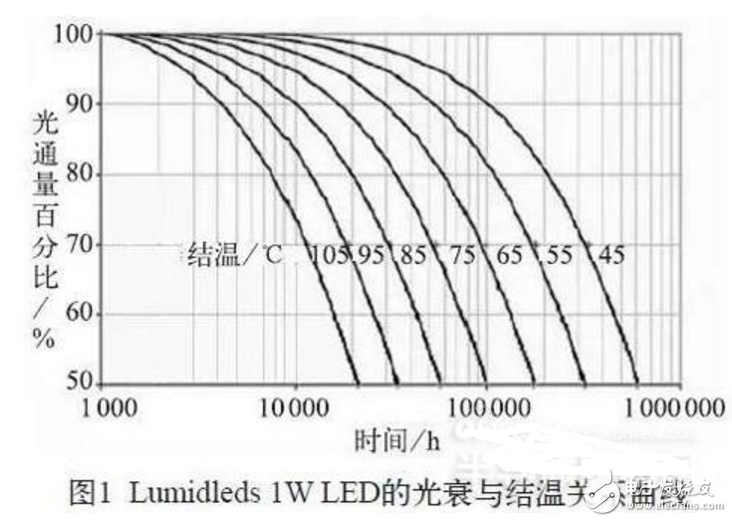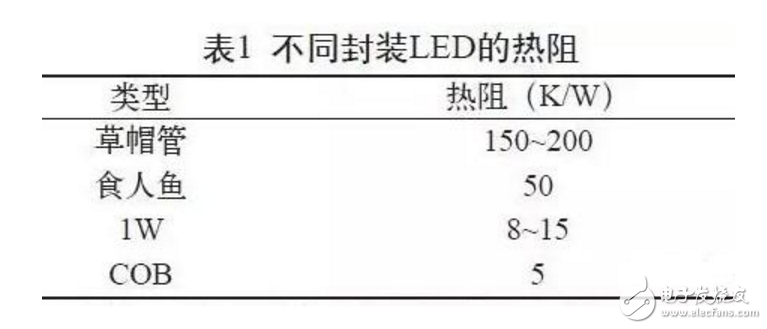With the continuous innovation of LED packaging technology and the implementation of energy saving and emission reduction policies at home and abroad, the proportion of LED light source applications in the field of lighting is increasing, and new packaging forms are constantly being introduced. The performance of LED in terms of heat dissipation, light efficiency, reliability, and cost performance is still a concern. If these breakthroughs are not made, or new products other than LEDs can make breakthroughs in the future, then the choice of lighting field may not be LED. COB (Chip on Board) is the LED packaging product introduced by the industry in this context. Compared with the traditional discrete LED packaging products, it has better primary heat dissipation capability and high-density luminous flux output. When designing the LED package structure, the junction temperature of the chip should be reduced as much as possible. The COB packaged chip has the shortest heat dissipation path, and can directly transfer the heat of the working chip to the metal substrate and then to the heat sink. Therefore, the COB has better heat dissipation capability than the conventional discrete component assembly. The material of the current COB metal substrate is copper, aluminum, aluminum oxide, aluminum nitride, etc., and aluminum is mainly used as a metal substrate in terms of overall cost, heat dissipation capability, and corrosion resistance. With the continuous innovation of LED packaging technology and the implementation of energy saving and emission reduction policies at home and abroad, the proportion of LED light source applications in the field of lighting is increasing, and new packaging forms are constantly being introduced. The performance of LED in terms of heat dissipation, light efficiency, reliability, and cost performance is still a concern. If these breakthroughs are not made, or new products other than LEDs can make breakthroughs in the future, then the choice of lighting field may not be LED. COB (Chip on Board) is the LED packaging product introduced by the industry in this context. Compared with the traditional discrete LED packaging products, it has better primary heat dissipation capability and high-density luminous flux output. When designing the LED package structure, the junction temperature of the chip should be reduced as much as possible. The COB packaged chip has the shortest heat dissipation path, and can directly transfer the heat of the working chip to the metal substrate and then to the heat sink. Therefore, the COB has better heat dissipation capability than the conventional discrete component assembly. The material of the current COB metal substrate is copper, aluminum, aluminum oxide, aluminum nitride, etc., and aluminum is mainly used as a metal substrate in terms of overall cost, heat dissipation capability, and corrosion resistance. The power loss of the LED device in operation is usually expressed in the form of thermal energy dissipation. Any part with resistance becomes an internal heat source, causing the heat density to rise sharply, so the temperature of the device itself also rises, and the surrounding ambient temperature will also increase. Affects internal temperature, which affects the reliability, performance and longevity of the LED. Studies have shown that as the temperature increases, the chip failure rate tends to increase. Therefore, reliable thermal design for LED packaging and implementation of effective thermal control measures are the key to improving its reliability. In the electronics industry, for every 10 °C increase in the ambient temperature of the device, the failure rate is often increased by an order of magnitude. This is called the "10 °C rule." Most of the methods currently used are based on the material of the circuit board, and some materials with high thermal conductivity and stability, such as copper, aluminum, ceramics, etc., are selected. However, it is not enough to improve the heat dissipation problem only through the circuit board. It is also necessary to improve the heat dissipation performance of the LED through other thermal design methods. Any electronic device and circuit is inevitably accompanied by heat generation. To improve its reliability and performance, heat must be minimized, and proper heat dissipation technology is the key. When the substance itself or when it comes into contact with matter, the transfer of energy is called heat conduction. This is the most common form of heat transfer. Light is transmitted by direct contact between particles with lower energy and particles with higher energy. In contrast, the heat transfer mode is limited to solids and liquids because the molecular composition of the gas is not very tight, and the transfer of energy between them is called thermal diffusion. The basic formula for heat transfer is: Q=K&TImes;A&TImes;ΔT/ΔL (1) Where Q is heat, which is the heat generated or conducted by heat conduction; K is the heat transfer coefficient of the material, the heat transfer coefficient is similar to specific heat, but it is different from the specific heat, the heat transfer coefficient is inversely proportional to the specific heat, and the heat transfer coefficient is higher. The lower the value of the specific heat. For example, the thermal conductivity of pure copper is 396.4, and its specific heat is 0.39; in the formula, A represents the heat transfer area (or the contact area of ​​two objects), ΔT represents the temperature difference between the two ends; ΔL is the distance between the two ends. . Therefore, we can find from the formula that the heat transfer is proportional to the heat transfer coefficient and heat transfer area, and inversely proportional to the distance. The higher the heat transfer coefficient, the larger the heat transfer area, and the shorter the distance traveled, the higher the energy of heat transfer, and the easier it is to carry away heat. As a new generation of light source, LED is gradually applied to general illumination. The most basic optical requirement is luminous flux. At present, there are two ways to increase the luminous flux of LED, which are to increase the brightness of the chip and multiple dense arrays. These methods need to be input. Higher power energy, and only a small part of the input LED energy will be converted into a light source, most of which will be converted into heat energy, and the multiplied current will be sent in a single package, and the heat will naturally double, so in such a small heat dissipation Under the area, the heat dissipation problem will gradually deteriorate. Like traditional light sources, LEDs generate heat during operation, depending on the overall luminous efficiency. Under the action of external electric energy, the radiation of electrons and holes recombines to produce electroluminescence, and the light radiated near the PN junction needs to pass through the semiconductor medium and the package medium of the LED chip to reach the outside. Comprehensive current injection efficiency, radiation luminescence quantum efficiency, external light extraction efficiency, etc., finally only 30%~40% of the input electrical energy is converted into light energy, and the remaining 60%~70% of the energy is mainly caused by non-radiative recombination lattice vibration. The form is transformed into heat. The increase in the temperature of the LED chip enhances the non-radiative recombination, further weakens the luminous efficiency, and shortens the lifetime. The heat dissipation technology adopted by the LED lamp must be able to effectively reduce the thermal resistance of the PN junction of the LED to the environment, in order to reduce the PN junction temperature of the LED as much as possible to improve the life of the LED lamp. Figure 1 shows the relationship between the light decay and junction temperature of Lumidleds1W LED under constant operating current. It can be seen that the higher the junction temperature, the faster the luminous flux decays and the shorter the lifetime. The thermal performance parameters of LEDs mainly refer to junction temperature and thermal resistance. The junction temperature of an LED is the temperature of the PN junction. The thermal resistance of an LED generally refers to the thermal resistance between the PN junction and the surface of the enclosure. The junction temperature is a parameter that directly affects the performance of the LED, and the thermal resistance is a parameter indicating the thermal performance of the LED. The smaller the thermal resistance, the easier the heat of the LED is conducted from the PN junction. The lower the junction temperature of the LED, the higher the sustained light efficiency of the LED and the longer the lifetime. When the temperature of the PN junction of the LED rises, it will cause the forward voltage drop of the LED to decrease, which means that once the LED in the loop has excessive temperature rise, the response of the PN junction will further increase the temperature of the LED if the LED If the temperature of the chip exceeds a certain value, the entire LED device will be damaged. This temperature value is the critical temperature. LEDs with different packaging materials have different critical temperatures, and even the same material, packaging process and other factors will affect the critical temperature. Different from the traditional light source, the printed circuit board is not only the power supply carrier of the LED, but also the heat dissipation carrier. Therefore, the thermal design of the printed circuit board (including pad placement, wiring, and plating) is especially important for the thermal performance of the LED. At present, the packaging of the LED chip is mainly in a single package, and the single package is only applied to 1~4 LED astigmatism lamps, and the astigmatism lamp has a short lighting time, so the heat accumulation phenomenon is not obvious. If it is applied to fluorescent lamps, it should be arranged closely and light up for a long time, so it is difficult to exclude these heats in time in a limited heat dissipation space. LED chips are characterized by extremely high heat generation in a very small volume. The heat capacity of the LED itself is very small, so it is necessary to conduct this heat out at the fastest speed, otherwise it will produce a high junction temperature. Although the LED chip architecture and raw materials are one of the factors affecting the thermal resistance of the LED, reducing the thermal resistance of the LED itself is an early condition, but after all, the impact on improving the heat dissipation capability is limited, so the LED is processed by selecting an appropriate LED packaging process technology. The main method of heat dissipation design. Table 1 lists the thermal resistance of LEDs in several different packaging processes that are common on the market. It can be seen that LEDs packaged with COB technology have the lowest thermal resistance compared to other packaging processes. Linear Array Sensor,Infrared Light Detector Device,Swir Linear Detector,Infrared Ingaas Sensor Ningbo NaXin Perception Intelligent Technology CO., Ltd. , https://www.nicswir.com
